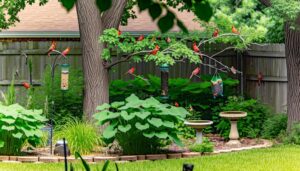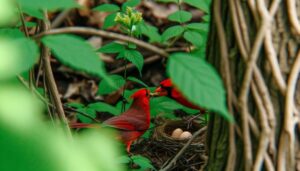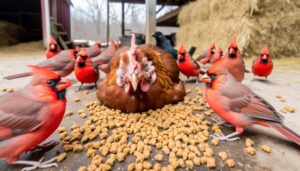7 Simple Steps to Make Cardinal Bird Food
To make cardinal bird food, combine high-quality sunflower and safflower seeds, which they prefer for taste and energy. Add black oil sunflower seeds for their high fat content and crushed peanuts for essential amino acids.
Incorporate berry bits like blackberries and blueberries to provide vitamins and antioxidants, vital for their vibrant plumage and health. Use mesh feeders or ground trays suited to cardinals' stationary feeding habits.
Make sure you store the mixture in airtight containers to maintain freshness and protect against pests. For ideal results, follow these steps to prepare a nutrient-dense blend that supports cardinal nutrition and overall well-being.
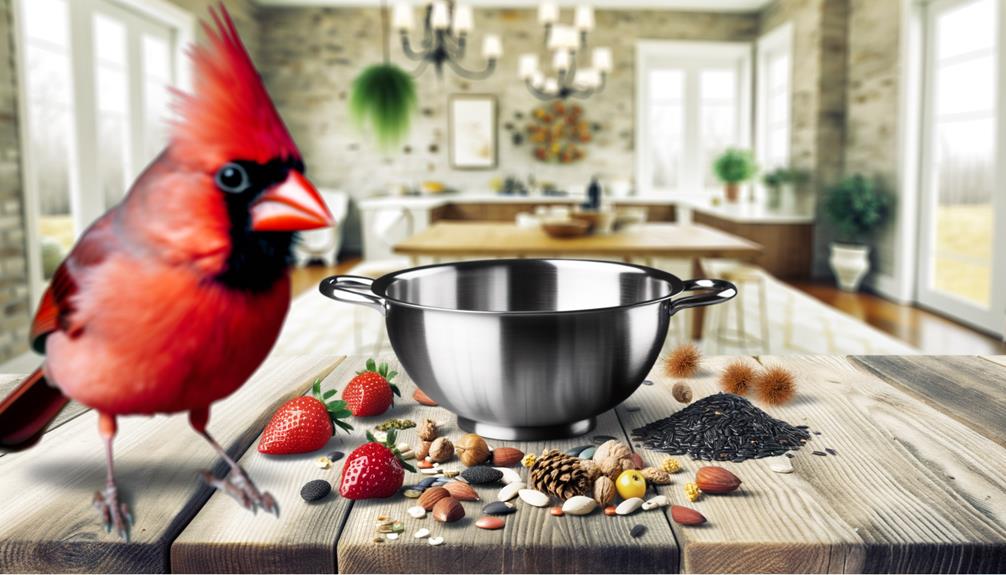
Key Takeaways
- Mix high-quality black oil sunflower seeds, safflower seeds, and crushed peanuts for a nutrient-rich blend.
- Include berry bits like blackberries and blueberries for essential vitamins and antioxidants.
- Use mesh feeders and ground trays to make food easily accessible to cardinals.
- Store seed blends in airtight containers in a cool, dry place to prevent spoilage.
- Place feeders at varying heights between 4-6 feet and near trees or shrubs for shelter.
Understanding Cardinal Diet
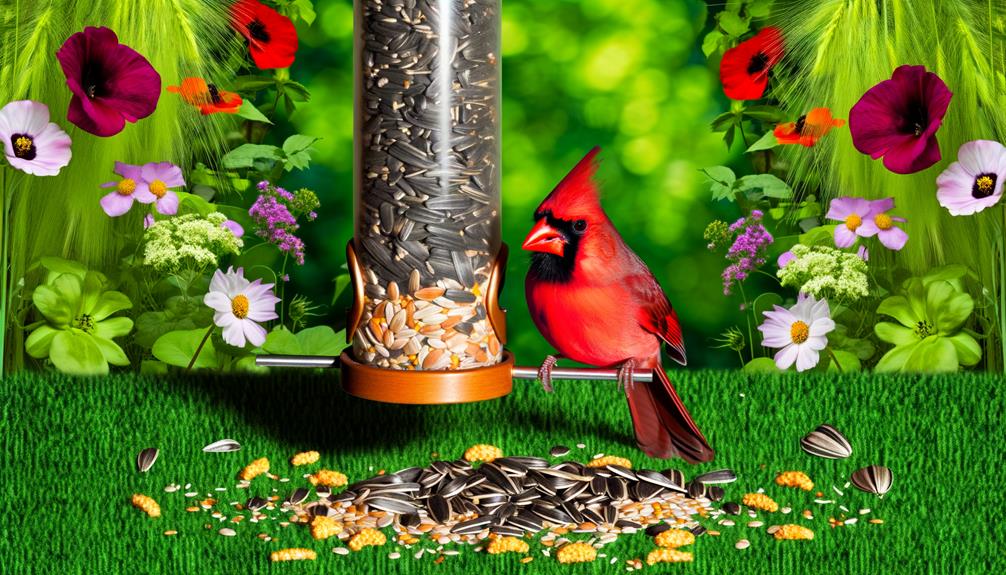
Understanding what cardinals eat is crucial for providing them with a nutritious diet that supports their health and natural behaviors.
You'll notice that cardinals are granivorous, primarily consuming seeds, particularly sunflower and safflower seeds. They're also partial to fruits and insects, which offer essential proteins and vitamins.
Observing their foraging behavior, you'll see they often crack seeds open with their robust bills, a behavior driven by their anatomical adaptation.
Pay attention to seasonal variations; during breeding seasons, they'll seek more protein-rich foods like insects. By comprehending these dietary preferences and behaviors, you guarantee cardinals get the necessary nutrients to thrive, maintain vibrant plumage, and exhibit normal mating and nesting activities.
Your aim is to mimic their natural diet as closely as possible.
Selecting Key Ingredients
To create a top cardinal bird food, prioritize selecting high-quality sunflower and safflower seeds, which are crucial to their diet.
Sunflower seeds, especially black-oil variety, offer high-fat content crucial for energy.
Safflower seeds, though less favored by other species, attract cardinals due to their unique taste preference.
Incorporate crushed peanuts; they provide proteins and essential amino acids essential for muscle maintenance.
Include millet in moderation; although not a primary choice, it complements their nutritional needs.
Berry bits, rich in antioxidants, mimic natural foraging behaviors.
Make sure all ingredients are fresh, free from mold and pesticides.
Gathering Supplies

You'll need to compile a detailed list of ingredients, ensuring each item meets the dietary needs of cardinals.
Observational data indicates that specific feeding tools like mesh feeders and ground trays optimize food accessibility and minimize waste.
Prioritize acquiring high-quality seeds and suitable feeders to encourage natural foraging behaviors.
Necessary Ingredients Checklist
Before you begin making cardinal bird food, make sure you have all the essential ingredients, including black oil sunflower seeds, safflower seeds, and crushed peanuts, as these provide best nutrition for cardinals.
Black oil sunflower seeds are high in fat and protein, critical for energy and reproduction. Safflower seeds, less appealing to squirrels, offer essential fatty acids and are a cardinal favorite. Crushed peanuts, rich in protein and fats, support muscle development and feather health.
Observing cardinals' feeding behavior, you'll notice they prefer seeds they can crack open with their strong beaks. Ensuring a balanced mix of these seeds caters to their dietary needs and enhances their vibrant plumage, promoting their freedom and liveliness in your garden.
Essential Feeding Tools
Acquiring the right feeding tools guarantees cardinals can easily access and enjoy the nutritious seeds you provide. Start with a sturdy, weather-resistant feeder. Opt for designs that allow easy seed access yet deter larger birds. Investigate models with perches, as cardinals prefer to feed while perched.
Position feeders in open areas with nearby shelter to offer both visibility and safety—cardinals are cautious and need a quick escape route. Clean feeders regularly to prevent disease spread, maintaining a hygienic environment.
Observational data shows cardinals are most active during early morning and late afternoon. For best outcomes, make sure feeders are filled during these peak times. By understanding their behavioral nuances, you'll attract and sustain a vibrant cardinal population.
Mixing Seed Blends
Selecting the right combination of seeds is essential for attracting and nourishing cardinals effectively. You'll want to focus on seeds that offer high energy and essential nutrients. Black oil sunflower seeds are a cardinal favorite due to their high fat content and ease of cracking. Safflower seeds are another excellent choice, providing a rich source of protein and fat while deterring less desirable birds. Cracked corn adds variety and is particularly appealing during colder months.
| Seed Type | Cardinal Preference |
|---|---|
| Black Oil Sunflower | Very High |
| Safflower | High |
| Cracked Corn | Moderate |
Observing behavioral patterns, you'll notice cardinals prefer stationary feeders over hanging ones, ensuring a stable feeding experience. Mixing these seeds creates an ideal, nutrient-dense blend that meets their dietary needs.
Adding Fruits and Berries
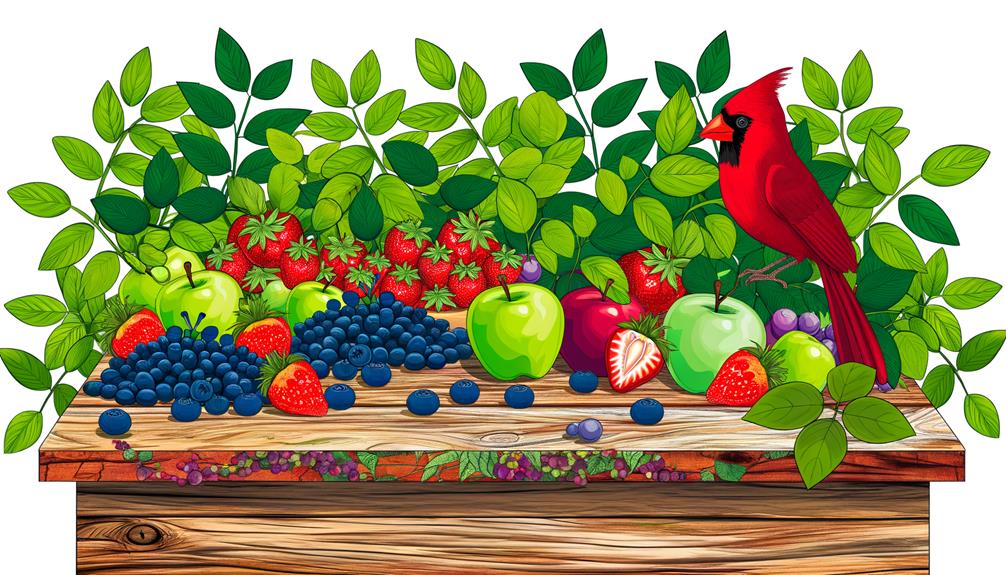
When incorporating fruits and berries into your cardinal bird food, opt for nutrient-dense options like blackberries, blueberries, and chopped apples. These fruits provide essential vitamins and antioxidants, promoting cardiovascular health and vibrant plumage.
To maximize appeal, present them fresh or slightly dried, ensuring they're easily accessible and free from pesticides.
Best Fruit Choices
To attract cardinals, you should consider incorporating a variety of fruits and berries such as grapes, apples, and blueberries, which provide essential nutrients and mimic their natural foraging habits.
Grapes, with their high moisture content, offer hydration and are easily consumed due to their soft texture. Apples, cut into manageable pieces, provide a sweet, energy-rich food source. Blueberries, rich in antioxidants, are a favorite due to their small size and ease of consumption.
Observations indicate cardinals exhibit a preference for brightly colored fruits, likely due to their visual acuity. By diversifying the fruit offerings, you'll enhance the appeal of your feeding station, encouraging these vibrant birds to frequent your backyard with regularity and enthusiasm.
Nutritional Benefits
Incorporating fruits and berries into a cardinal's diet greatly enhances their nutritional intake by providing essential vitamins, minerals, and antioxidants that support overall health and well-being.
Fruits like apples and berries such as blueberries are rich in vitamin C, which bolsters the cardinal's immune system. Additionally, the natural sugars in these fruits supply immediate energy, crucial for their active lifestyle.
Observations indicate that cardinals consuming a diet with diverse fruits demonstrate vibrant plumage and increased vitality. Behavioral insights reveal that cardinals, with their strong beaks, effectively consume a variety of fruits, adapting well to different textures.
Serving Suggestions
Start by offering a variety of fruits like apples, blueberries, and strawberries in small, easily accessible feeders to attract cardinals and support their nutritional needs.
You'll notice that cardinals exhibit a preference for fruits high in natural sugars, which provide quick energy. Place the feeders in an open area where cardinals can spot them easily but also feel secure from predators.
Monitor the feeders regularly and replenish the fruit to guarantee freshness. Cardinals are known for their distinct foraging patterns, often returning to reliable food sources.
Incorporating Nuts and Seeds
Cardinals thrive on a diet rich in nuts and seeds, which provide essential nutrients and energy for their vibrant plumage and active behavior. To cater to their dietary needs, incorporate the following nuts and seeds into your bird food mix:
- Black Oil Sunflower Seeds: High in fat, these seeds are a cardinal favorite, promoting feather health and energy.
- Safflower Seeds: These are less favored by squirrels, ensuring cardinals get their share.
- Peanuts: Rich in protein and fat, peanuts support muscle development and overall strength.
- Cracked Corn: This provides a good carbohydrate source, helping cardinals maintain their energy levels.
Observing cardinals, you'll notice their preference for these nutrient-dense options, which support their dynamic movements and striking appearance.
Preparing Suet Cakes
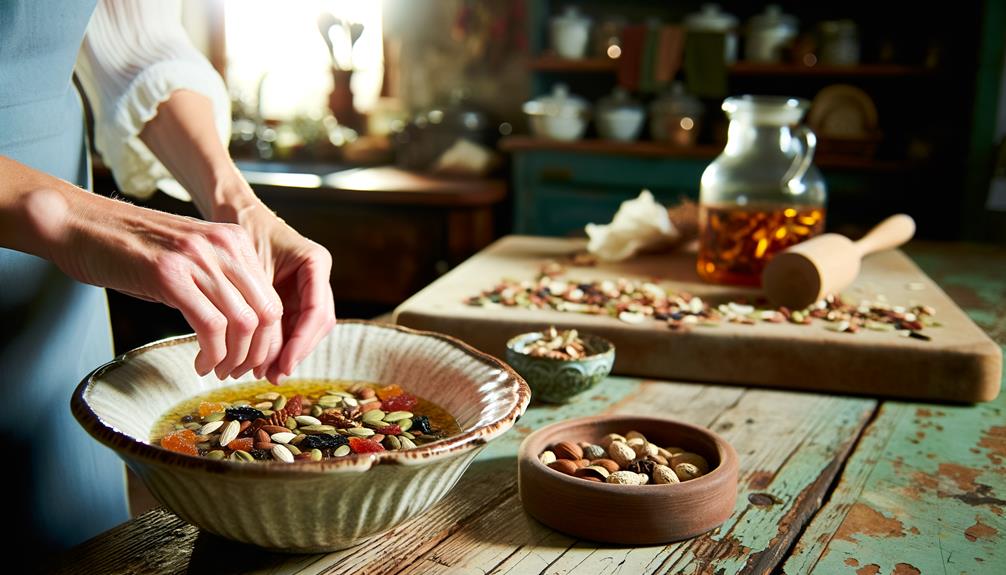
To further enhance the cardinals' diet, you can prepare suet cakes that are rich in fats and proteins, providing a high-energy supplement especially beneficial during colder months. Begin with rendered beef fat as your base; it's nutrient-dense and highly caloric.
Melt the fat over low heat, ensuring you maintain a homogeneous mixture. Integrate ingredients like peanut butter, cornmeal, and finely chopped nuts, which offer essential amino acids and additional lipids. Once mixed, pour the blend into molds and allow it to solidify.
Cardinals exhibit an increased metabolic rate in cold weather, making these suet cakes invaluable. Observationally, they prefer feeding early morning and late afternoon, so place the cakes where sunlight can naturally highlight the feeding area, enhancing their visibility and appeal.
Storing Homemade Bird Food
When storing homemade bird food, make sure it's kept in airtight containers to prevent moisture and pests from compromising its quality. Proper storage maintains the nutritional integrity and freshness essential for attracting cardinals.
Here are some key steps:
- Airtight Containers: Use BPA-free plastic or glass jars with secure lids.
- Cool, Dry Place: Store containers in a pantry or cupboard away from direct sunlight.
- Labeling: Mark the preparation date on each container to monitor freshness.
- Periodic Inspection: Regularly check for any signs of mold, pests, or spoilage.
Setting Up Bird Feeders
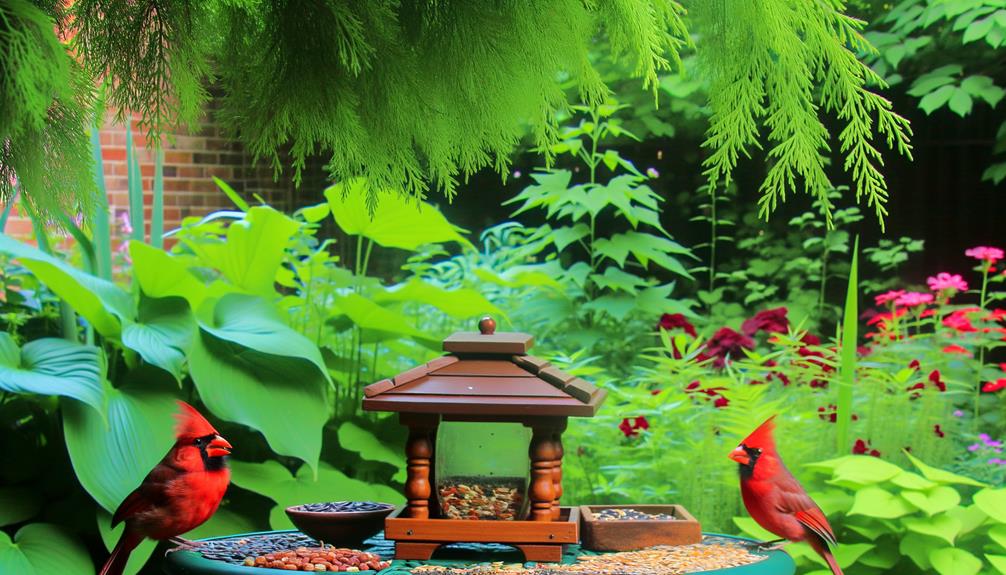
When setting up bird feeders, you'll need to think about the best location to guarantee safety and accessibility for cardinals.
Choose feeder types that accommodate their feeding habits, such as platform or hopper feeders.
Regularly maintain and clean the feeders to prevent disease and promote a healthy feeding environment.
Choosing Feeder Location
Selecting the best feeder location requires an understanding of cardinal behavior and environmental factors. You need to take into account their preference for low, protective cover and proximity to water sources.
To optimize your feeder setup, follow these guidelines:
- Height: Place feeders 5-6 feet above ground to deter predators while providing easy access for cardinals.
- Shelter: Position feeders near shrubs or trees, offering a quick escape route from threats.
- Visibility: Consider feeders are visible from your home, enhancing your bird-watching experience and making it easier to monitor food levels.
- Sunlight: Choose a location with partial shade to prevent seed spoilage and provide a comfortable feeding environment.
Selecting Feeder Types
Understanding cardinal feeding preferences is essential for choosing the most effective feeder types. Cardinals prefer feeders that offer stability and ease of access due to their relatively large size. Opt for platform or hopper feeders, as these designs provide the necessary support and ample perch space.
Observational data indicates that cardinals exhibit a preference for feeders with a protective cover, shielding them from adverse weather conditions. Additionally, cardinals are less likely to frequent feeders that are too close to the ground, as higher placements reduce predation risks.
Maintaining Clean Feeders
To safeguard cardinal feeders remain appealing and safe, you must regularly clean and maintain them to prevent mold, bacteria, and other contaminants. This safeguards a healthy feeding environment, preserving the cardinals' wellbeing.
Follow these steps:
- Weekly Cleaning: Dismantle the feeder and wash it with hot, soapy water. Rinse thoroughly to remove soap residue.
- Sanitizing: Use a diluted bleach solution (1 part bleach to 9 parts water) to sanitize the feeder. Soak for 10 minutes, then rinse completely.
- Drying: Make certain the feeder is completely dry before refilling to prevent mold growth.
- Inspection: Regularly check for wear and tear, such as cracks or rust, which can harbor bacteria.
Tips for Attracting Cardinals
Consistently providing a variety of seeds, especially sunflower and safflower, can greatly enhance your chances of attracting cardinals to your yard. Cardinals exhibit a strong preference for these seeds due to their high-fat content, essential for energy.
Place feeders at varying heights, ideally between 4-6 feet, mimicking natural feeding behaviors. Opt for feeders with larger perches to accommodate their size.
Include dense shrubs and trees nearby to offer shelter and nesting sites, as cardinals favor secluded areas. Water sources, like bird baths, can augment your efforts, ensuring hydration.
Observe cardinal activity patterns; they're most active during dawn and dusk. By aligning your feeding schedule with their natural rhythms, you'll create an inviting environment that cardinals can't resist.
Conclusion
By following this guide, you'll create a nutritious feast that caters to cardinals' dietary needs.
Can you imagine the vibrant splash of red these fascinating birds will bring to your yard?
With carefully selected seeds, fruits, and suet, and strategic feeder placement, you'll observe their unique social behaviors and feeding patterns up close.
So, gather your supplies, mix those blends, and watch as these beautiful creatures flock to your well-prepared sanctuary.
Your backyard will soon be a cardinal haven!

